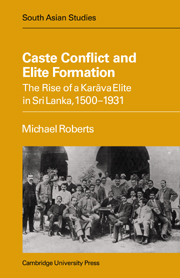Book contents
- Frontmatter
- Contents
- List of figures, chart and maps
- List of tables
- Preface
- Glossary
- List of abbreviations
- Map 1 The Kingdoms of Kotte and Kandy
- Map 2 Some physical features and place names
- Map 3 Present administrative divisions and the contemporary migration patterns of fishermen
- Map 4 The coastal waters of Sri Lanka and southeastern India
- 1 Introduction
- 2 The Karāva in the past
- 3 Caste among the Sinhalese
- 4 Economic opportunities and social relations, 1500s–1790s
- 5 The British period: the economic advances of a Karāva elite
- 6 Social competition, caste conflict and manifestations of Karāva power
- 7 Casteism in South Asian politics during British times: emergent cultural typifications or elite fictions?
- 8 Causal factors in the moulding of Karāva entrepreneurship and the emergence of a Karāva elite
- 9 Concluding remarks
- Tables
- Appendix 1 Problems and cautionary notes concerning the information derived from the plantation directories in the sequential series known as Ferguson's Ceylon Directory
- Appendix 2 A contemporary newspaper account of the reception provided for a Karāva notable on his receiving the title of ‘Mudaliyar of the Governor's Gate’ in 1853
- Appendix 3 A list of caste pamphlets and caste literature in chronological order, 1864–1930
- Select bibliography
- Index
5 - The British period: the economic advances of a Karāva elite
Published online by Cambridge University Press: 30 October 2009
- Frontmatter
- Contents
- List of figures, chart and maps
- List of tables
- Preface
- Glossary
- List of abbreviations
- Map 1 The Kingdoms of Kotte and Kandy
- Map 2 Some physical features and place names
- Map 3 Present administrative divisions and the contemporary migration patterns of fishermen
- Map 4 The coastal waters of Sri Lanka and southeastern India
- 1 Introduction
- 2 The Karāva in the past
- 3 Caste among the Sinhalese
- 4 Economic opportunities and social relations, 1500s–1790s
- 5 The British period: the economic advances of a Karāva elite
- 6 Social competition, caste conflict and manifestations of Karāva power
- 7 Casteism in South Asian politics during British times: emergent cultural typifications or elite fictions?
- 8 Causal factors in the moulding of Karāva entrepreneurship and the emergence of a Karāva elite
- 9 Concluding remarks
- Tables
- Appendix 1 Problems and cautionary notes concerning the information derived from the plantation directories in the sequential series known as Ferguson's Ceylon Directory
- Appendix 2 A contemporary newspaper account of the reception provided for a Karāva notable on his receiving the title of ‘Mudaliyar of the Governor's Gate’ in 1853
- Appendix 3 A list of caste pamphlets and caste literature in chronological order, 1864–1930
- Select bibliography
- Index
Summary
After their conquest of the Maritime Provinces in 1795–6, the British eventually took control of the Kandyan Kingdom in 1815. Initially, a separate administration under the governor was maintained in the latter territory. It was not till 1833 that the two territories were brought under a unified administrative system. While continuing to rely on indigenous headmen for district and village administration, the tendency was to bring these functionaries under increasing control and to set up specialised departments (e.g. survey, public works, police) as the need arose. In the meanwhile, the separation of the judicial and executive branches of administration promoted the evolution of a network of judicial posts and services. This process of political and administrative unification was cemented during the course of the nineteenth and twentieth centuries by the extension of communications. Begun in the 1820s, the Colombo–Kandy road was fully bridged and completed by 1832. If the construction of this road was motivated largely by strategic political considerations, subsequent road building was stimulated by economic growth and economic motives, though a few roads were also constructed to serve administrative needs. Though not without regional unevenness, the island's road network has long been one of its most remarkable and economically significant features. This network was soon supplemented by the development of postal and telegraphic services, the completion of a railroad from Colombo to Kandy in 1867, the subsequent elaboration of a rail network till it had encompassed a mileage of 713 by the year 1924 and the development of an artificial harbour at Colombo by the 1880s.
- Type
- Chapter
- Information
- Caste Conflict Elite Formation , pp. 98 - 130Publisher: Cambridge University PressPrint publication year: 1982



